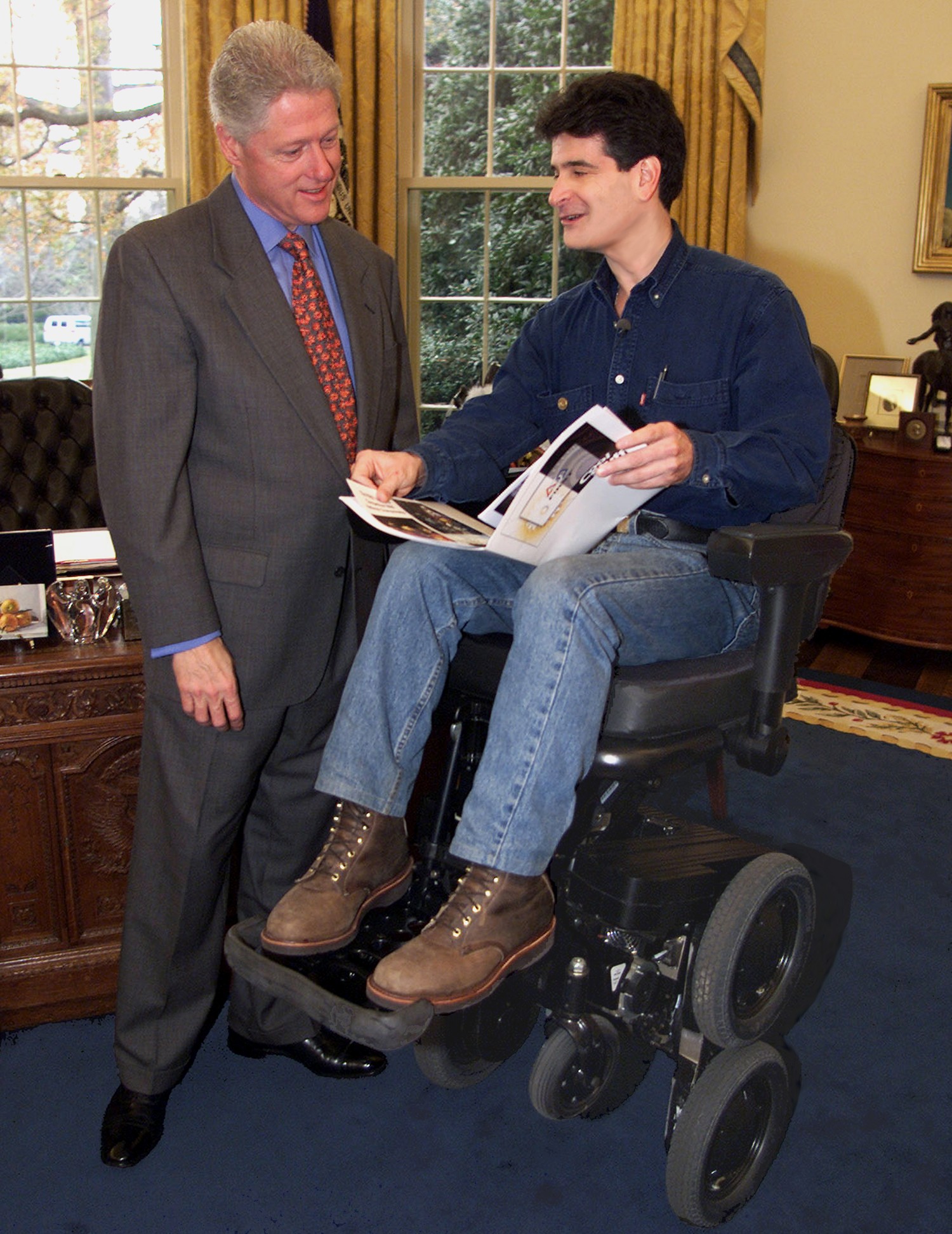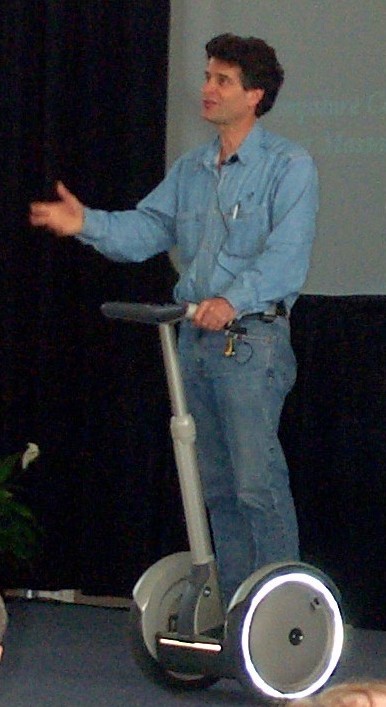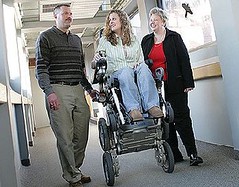|
|
| This picture shows Bill Clinton and Dean Kamen in the office of the president. Kamen is on his iBot. (Photo credit: Wikipedia) |
The story of the
iBot is a potentially heartbreaking one. This exceptional wheelchair, which can climb stairs, navigate difficult terrain in four-wheel-drive mode, and elevate its user up to eye level with standing people, is no longer being manufactured or sold. In fact, if nothing changes, maintenance and parts for the iBot will only be available through March of 2014. After that date, I don't know if my iBot will run 10 minutes or 10 years before a fatal malfunction occurs. Yet, not all hope is lost. Some very talented and dedicated people are still trying to save the iBot.
Through my affiliation with
Huey 091 and
SavetheiBot.org I was introduced to Joe, the Special Projects Officer at
DEKA Research and Development. DEKA is the company founded by entrepreneur and inventor
Dean Kamen. They are responsible for such innovative products as the
Segway transporter, the iBot wheelchair, and countless other devices that help people lead better lives.
I asked Joe if he could give me a tour of the DEKA facility, and he agreed. One day in early November Kim and I made the hour and half drive from South Portland, Maine to Manchester, New Hampshire.
I’m an engineer, and DEKA is all about that. They have almost 500 technical people on staff in Manchester. Kim is a Middle School Guidance Counselor, and she had only a passing interest in this tour. In fact, she was participating only as a favor for me, which was nothing unusual. Kim is a very generous person.
Joe greeted us when we arrived at DEKA, and introduced our tour guide, Sarah, who is Dean Kamen’s Chief of Staff. Joe indicated that Dean had wanted to meet us, but unfortunately he was out of the office on this day. (Did I mention that a couple of years ago I was
almost personally introduced to another great inventor,
Steve Wozniak?)
I asked if we were allowed to take pictures, even though I was pretty sure of the answer. Indeed, DEKA works on many top secret projects, and they don’t allow photography inside their facility. I get that.
First, Sarah shared the background story about Dean Kamen and DEKA, showing off a few of the early products he developed. This included a drug delivery system that later became the first insulin pump for diabetics, and a portable dialysis machine.
We were then guided to the machine shop area of the facility, where they have a rare 3-D printer that works with metals. DEKA also operates a bank of more traditional 3-D printers that work with plastics (if any version of these machines can yet be considered
traditional). A collection of products that come off of these devices was on display, and they were amazing. If you’re not familiar with 3-D printers, and why every home will have one in the coming years, read
this article.
Sarah and Joe then introduced us to some of their more recent projects. Dean is concerned about the availability of potable water in Third World countries, so they developed a pair of products to address this issue. The
Slingshot is a self-contained, highly efficient water purification unit that can be easily deployed anywhere in the world. DEKA is partnering with Coca-Cola to make these units available where they are most needed. The
Stirling Engine is a self-contained generator appliance that can power a Slingshot and satisfy other local electricity needs using a variety of nonconventional fuels.
The Slingshot and the Stirling Engine are very cool, but the most impressive product we saw was DEKA’s prosthetic arm, called the
Luke Arm. Development is being funded by the Department of Defense (
DARPA). We met up with the Manager of Engineering, Stewart, who explained the project to us. It’s heartwarming to watch an amputee pick up grapes and place them in his mouth, or drink a bottle of water without crushing or spilling it. The goal is to make this technology available to war veterans with arm amputations, and eventually anyone who can benefit from this prosthetic device.
Our last stop on the tour was the iBot testing facility. Years ago DEKA created a series of indoor obstacles for the purpose of putting the iBot through its paces during development. There are ramps, curbs, stairs, and your worst nightmare of a bumpy walking path. But now it all sits idle, frozen in time while the fate of the iBot is determined. I’m glad we were shown this area, although I was slightly unnerved by its resemblance to a museum exhibit. Yet, I find it telling that DEKA has not decommissioned this testing facility and reallocated the space to active projects. They obviously haven’t given up, and so neither should we.
After the tour was complete, we enjoyed a lunch with Joe and discussed the future of the iBot. Joe’s number one priority is to facilitate its rebirth. After DEKA developed the iBot in the early 2000’s they licensed the technology to Johnson & Johnson, who created a subsidiary called Independence Technology for the production, sales, and service of the iBot. Five years ago, about six months after I purchased my own iBot, Independence Technology announced that they were discontinuing production. This was due to low sales volume and, I can only assume, business unit losses.
The primary reason for this product’s commercial failure was its onerous regulatory burden. For one thing, the iBot is categorized as a Class III medical device by the FDA, which means that extraordinary effort is required to obtain approval for any product modifications or enhancements. This places an undue burden on the development team and slows down or prevents improvements that consumers rightfully expect. For this and other reasons, the product underperformed in the marketplace, even though it has been a life-changing success for any individual lucky enough to own one, myself included.
The iBot needs a new manufacturer. But first, the regulatory environment must be improved. DEKA initiated an application to have the FDA modify the status of the iBot from a Class III medical device to Class II medical device. This would significantly reduce the regulatory burden on the product. The FDA received over 280 letters in support of this change, including one from me. On December 12 a team from DEKA will meet with the FDA Medical Devices Advisory Committee (it would have been sooner but for the government shutdown). After the meeting, we should have a much better idea of the viability of this petition. If it is eventually approved, DEKA will be in a stronger position to recruit new manufacturing partners.
I’ll let you know what I hear from the
December 12 meeting.
The people at DEKA were extremely friendly and gracious. More than one of them commented about how much they enjoy seeing people like me benefiting from their invention – the iBot. I envy them in that sense. I never worked for a company where I felt I was making such a positive impact in the world (few people do). Also, their affection for Dean Kamen is palpable and infectious. He’s one of my personal heroes.
I can’t thank Joe, Sarah, and Stewart enough for taking the time to share their knowledge and their passion with us. In the end, Kim admitted to me that this trip was much more rewarding than she thought it was going to be. Although the tools employed at DEKA may be highly technical, the folks there are motivated by compassion for others, and it doesn’t take an engineer to appreciate that.
Note: for more information on the effort to save the iBot, please visit these sites:
America’s Huey 091 Foundation
SavetheiBot.org
Save the iBot (Facebook Page)
My iBot Videos


























